What Are Baby Killer Whale Baby Called What Are Grown Ups Belegua Whales
Beluga whale, white whale (Delphinapterus leucas)
An albino marine mammal with a sizeable melon responsible for echolocation. The white whale is unmistakable among any other marine animals. As recognizable as a killer whale, as friendly as a dolphin.
Nomenclature
- Class: Mammalia
- Order: Cetartiodactyla
- Family: Monodontidae
- Genus: Delphinapterus
- Species:Beluga whale, white whale (Delphinapterus leucas)
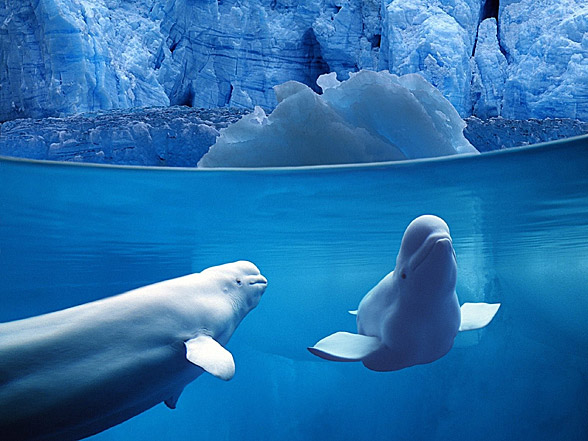
Areas of occurrence
It inhabits the cold Arctic and sub-Arctic waters, swimming in the deep coastal waters nigh Alaska, Northern Canada, Western Greenland and Northern Russia during summertime. In the summer it can exist observed in the St. Lawrence River, in close proximity to the Shantar Islands and Sakhalin Island (in the Sea of Okhotsk) plus the Amur River estuary.
The beluga whale migrates on a seasonal basis – when the areas it inhabits in summer are frozen nevertheless with the turn of autumn, for wintertime it moves to the open up ocean covered only with cracked drift water ice, or even waters topped with ice packs, drawing jiff only from the natural air holes, which allow them to resurface from time to time.
In summer, afterward thaw it migrates to more shallow, coastal waters (1 – three yard of depth (iii – 10 ft)), withal it sometimes happens to cull deeper areas – up to 800 k (2600 ft) deep. During summertime it as well inhabits the continental shelf areas and often swims into river estuaries. Belugas pond hundreds or even thousands of kilometers from the bounding main were multiply recorded.
The white whale also observes the fish migration (especially salmon). Rivers are a safe haven for baby whales, for their nemesis – killer whales – ordinarily go on away from the inland waters.
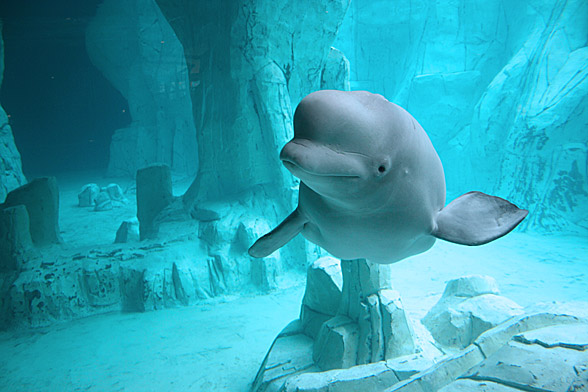
Characteristics
Its fusiform, elongated body tapers to a greater extent in the caudal area than in the cephalic region. The narrowing at the base of skull (neck) creates the impression of having shoulders, which makes beluga'due south appearance extraordinary among other cetaceans. The pectoral fins spread widely, being brusque and rounded. The tail fin is centre-shaped and orientated horizontally.
As well-nigh toothed whales a beluga too has a melon located in its forehead, which allows it to benefit from echolocation. The melons holds a semi-fluid fat tissue. As opposed to other cetaceans, its melon's outline is very distinctive – it has a bulb-similar shape. Interestingly, the melon is deformative – its shape changes along with the emitted sounds.
Unlike dolphins' the beluga's cervical vertebrae are not conjoined, information technology allows the animal to twist its head without turning the whole torso. Every bit a issue it has a larger field of vision, hunts more finer and can dodge predators' attacks. Its oral cavity holds modest, blunt and slightly kleptomaniacal teeth, a total of 36 – 40 in every jaw. They are non designated for chewing, rather for catching the prey, which is swallowed whole.
At the tiptop of beluga'due south head, behind the melon, a single spiracle is visible, surrounded by smooth muscles which allow the animal to close it tightly when underwater. The thyroid gland is much larger than land mammals' glands – it is 3 times every bit heavy as a equus caballus'southward thyroid, allowing the whale to boost its metabolism during summer, when living in the river estuaries. The dorsal fin disappeared leaving a noticeable 'hump' which, combined with the head – allows furrowing air holes in ice upwardly to 8 cm thick (3 in).
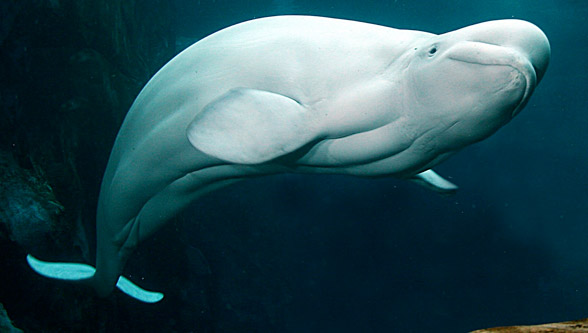
Hearing
One of the most developed senses of that species. It can hear sounds ranging from 1.2 – 120 kHz, being most sensitive to frequencies from 10 to 75 kHz (the average human hearing range is 0.02 -twenty kHz).
Sight
It sees well both over- and underwater, tough beluga's sight is rather poor when compared to dolphins'. Eyes are all-time adapted to seeing underwater, yet in contact with atmospheric air the vision arrangement accommodates to unlike environment. Its seeing abilities resemble the characteristics of the nearsighted.
The centre has both rod and cone cells, so presumably the creature is able to meet fifty-fifty in low calorie-free situations. The glands located in the interior corners of the optics secrete a fatty, jelly-similar substance which greases the eyeball and allows to remove foreign objects.
Touch, taste, smell
It has been observed that belugas like to remain in concrete contact (not to be mistaken with sexual relations) with other belugas. Their mouths hold so called chemoreceptors, allowing to distinguish various tastes. Furthermore a beluga whale can sense the taste of blood in the water – in such situation it reacts with panic. Similarly to other toothed whales, it lacks smell-brain and olfactory fretfulness, which suggests it does not accept a sense of odor.
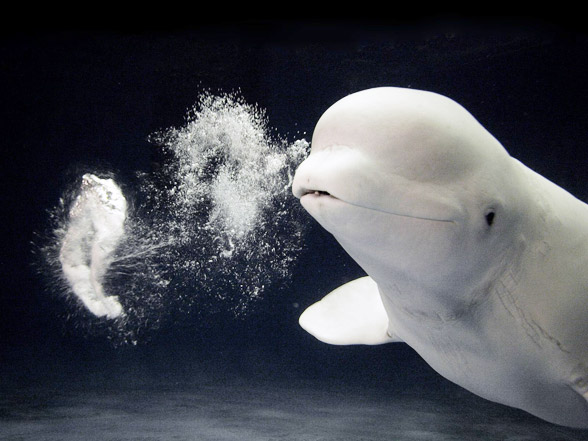
Color
An adult animal is unmistakable for any other species, for merely this whale is completely white or white-to-grey. Notwithstanding calves are built-in grey, becoming black or blue-grey after a month. They gradually drop their coloration finishing with a vivid white colour. The terminal coloration is reached at vii (females) and 9 (males) years of age.
The coloration is a result of adapting to life in the Arctic for information technology provides camouflage in the polar ice cap, protecting belugas from killer whales and polar bears – main predators hunting for those beautiful mammals.
The epidermis thickens in winter: the skin becomes xanthous, mostly in the dorsal area and on fins. During summer, after migrating to the river estuaries belugas rub themselves against gravelly river bed to become rid of the old skin blanket. To rephrase: beluga sheds it skin, being the only cetacean to do and then.
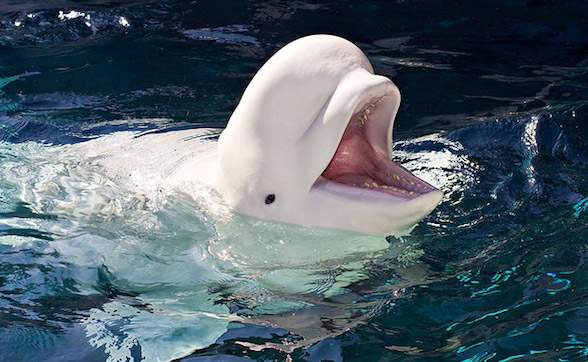
Lifestyle
Diet
Beluga whale is an opportunistic species – information technology hunts for whatsoever prey is the easiest and quickest to catch. Its dietary habits depend on the subpopulation and flavor of the year. The Beaufort Sea whales tin swallow Chill cods, while those found in the Greenland area hunt for rose fish, northern prawns (Pandalus borealis) and Greenland halibuts.
Alaskan subpopulations mostly prefer Pacific salmons. Also those species beluga eagerly hunts for capelins, flounders, smelts, salmons, squids, clams, bounding main snails, octopi, polychaetes and other deep-sea species.
It normally hunts in depths ranging from xx to forty meters (65 – 130 ft), yet it can swoop up to 700 m (2300 ft) deep. A flexible neck assures a full range of movement during food search at the bottom of the sea. Information technology often hunts in groups containing around 5 whales to bulldoze fish shoals to shallow waters, attacking them after.
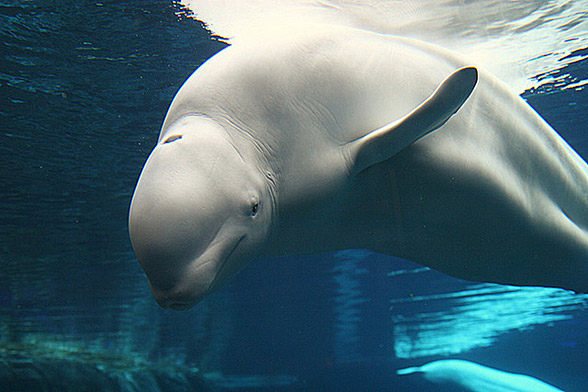
Diving
It usually dives upward to 20 meters (65 ft) deep, though it is able to penetrate much greater depths – ranging from 400 to 700 meters (1300 – 2300 ft). The deepest beluga diver was recorded at the depth of 872 m (2860 ft). One dive routinely lasts for iii – 5 minutes, yet it can stretch to 15 – eighteen minutes. In the shallow river estuaries an boilerplate dive is nigh 2 minutes long: a sequence consists of 5 – half-dozen quick shallow dives, followed by a deeper swoop, typically around ane infinitesimal. Beluga dives 31 – 51 times a twenty-four hours.
During a dive the animal'due south heart rate drops from the initial 100 beats per minute to 12 – 20 bpm. Only the most vital organs are supplied with blood: brain, heart and lungs, requiring constant oxygen flow. Furthermore beluga'due south muscles have very high levels of a certain protein – myoglobin, which is responsible for storing the oxygen inside the muscles. The concentration of this protein in beluga's muscles is several times as loftier as in case of land mammals, which helps avoiding oxygen deficiency during a dive.
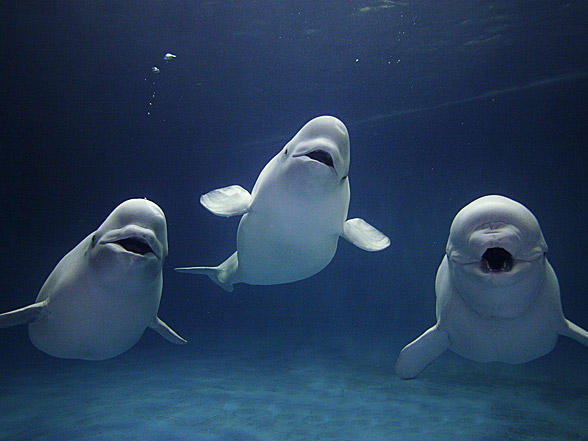
Social beliefs
Much as a common bottlenose dolphin (Tursiops truncatus) beluga is a highly sociable brute – it oft forms small groups containing upward to 25 whales, nevertheless usually one grouping holds about 10 animals. However these groups are not permanent and certain whales happen to change their affiliation. A group consists of both males and females, the groups are not sexual practice-based. Information technology is lead by a ascendant male.
When in pod, belugas hunt each other, seemingly for entertainment. In captivity they are highly curious towards humans and often swim close to the aquarium glass to accept a practiced look of them. It is common for belugas to spit at their trainers or aquarium keepers, they even try to spit at people behind the aquarium drinking glass. This phenomenon has not been fully explained, yet it is believed that spitting is a result of their addiction of bravado sand off the crustaceans at the sea lesser.
Wild-living whales also evidence remarkable interest towards humans and often swim in their company. Beluga tends to play not only with the animate creatures (humans, plants), simply as well with… non-breathing objects (sticks, dead fish, air bubbles which it creates by itself). In the convenance flavor adult whales swam with plants, nets or even a dead reindeer skeleton placed on their caput or back. Females which lost their offspring were usually seen swimming eastward.g. 'accompanied' past a buoy.
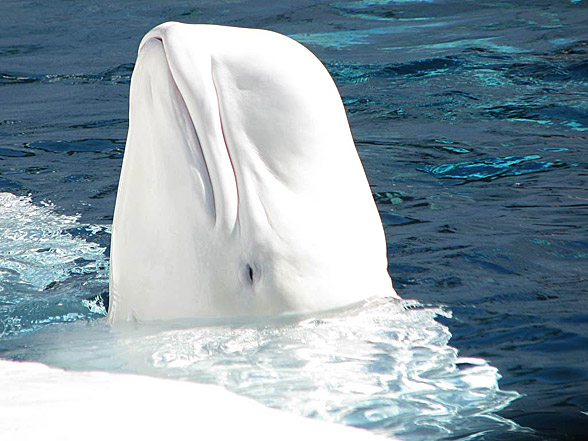
Convenance
Pregnancy lasts from 12 to 14.five months, but a female pregnancy lasting over 15 months (475 days) was recorded. A female person gives birth to one dogie normally once every three years. The breeding season takes place between February and May, notwithstanding some animals (or even whole populations) mate in other seasons of the year. Females reach sexual maturity between four and 7 years of historic period, while males 4 – nine years.
Female beluga gives nascence for the first time around 8 years of age, the level of fertility drops after reaching 25 years. Beluga can filibuster implantation (implanting the fertilized ovum in the womb). The babies – depending on the inhabited area – are born between March and September, at the finish of June or between late July and early August.
The birth takes place in the river estuaries and bays, where the h2o is warm – 10 – 15oC (l – 59 ºF). The calf is almost 1.5 m (4ft 11in) long and weighs effectually 80 kg (176 lb), it has a grayish skin color. It swims alongside its female parent right after being built-in. The infant is dependent from its mother for approximately 1 year, until all its teeth abound out. After this time prawns and small fish are added to its menu.
Most mothers breastfeed their offspring until 20 months of age, despite the calf'southward solid nutrient diet. It is not uncommon for lactation to final over 2 years. In captivity it has been observed that calves are taken care of by females other than their mothers. Perchance a similar miracle too takes place in the wild.

Detailed characteristic / size
Beluga whale / white whale (Delphinapterus leucas)
- Length:
- males: three,5 – v.v k (11ft 6in – 18ft)
- females: 3 – 4.1 m (9ft 10in – 13ft 5in)
- Weight:
- males: 1100 – 1600 kg (2425 – 3527 lb), sometimes 1900 kg (4188 lb)
- females: 700 – 1200 kg (1543 – 2645 lb)
- Lifespan: 25 – 30 years
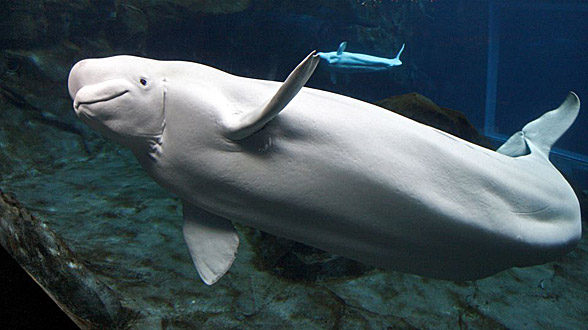
Beluga whale, white whale – interesting facts
- It has been proven that being in a river environment, this mammal's metabolism is boosted, helping the seasonal epidermis regeneration.
- Calves frequently render to the same estuary as their mothers.
- Beluga has a remarkably large thyroid gland, which may result in frequent overgrowth of this gland, or neoplastic lesions.
- Supposedly a white whale can see in color, yet this information has not yet been confirmed.
- These mammals in captivity eat two.5 – 3 % of their body mass on a daily basis – this means eighteen.2 – 27.two kg (40 – 59 lb) of fish.
- Commonly it swims rather slowly: iii – 9 km/h (one.9 – 5.6 mph), yet it tin reach a maximum speed of 22 km/h, which can be maintained for even 15 minutes.
- Beluga can swim backwards.
- Despite being a shut relative with a common bottlenose whale, information technology customarily does not bound over the h2o surface.
- twoscore – 50 % of its body mass is fat tissue.
- In the Nineteen century beluga whales were called 'sea canaries' due to the high-pitched sounds it creates.
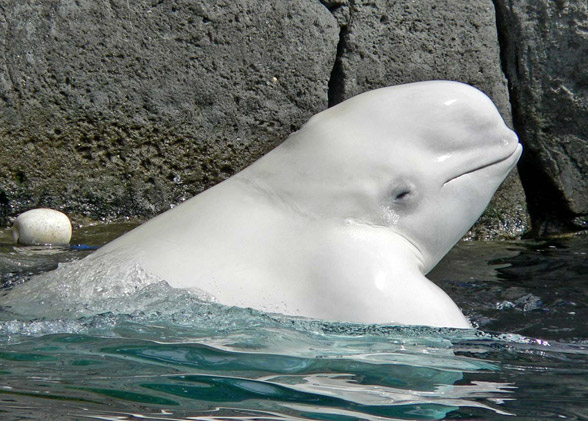
Recommended
- Marine
- Bluish whale
- Megalodon
- Great white shark
- Whale shark – largest fish
- Longest whales
- Heaviest whales
- Largest sharks
- Extinct animals
- Brute fights
- American panthera leo
- European cave king of beasts
- Smilodon – Saber-toothed tiger
- Fastest animals
- Fastest birds
Source: https://dinoanimals.com/animals/beluga-whale-white-whale/
0 Response to "What Are Baby Killer Whale Baby Called What Are Grown Ups Belegua Whales"
Enregistrer un commentaire